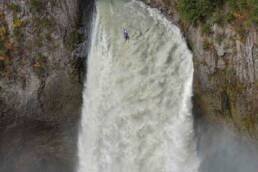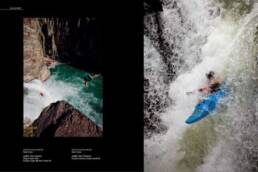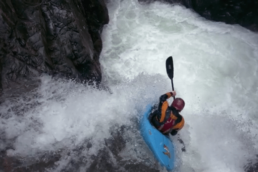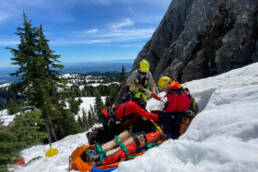It was a Cascadian kayaking feat that will never be repeated. How a mad mountain scientist and one seriously sick spaniard unlocked keyhole falls for the first but final time.
Spanish kayaker Aniol Serrasoles’ had a mission to paddle the “scariest waterfall drop you’ve ever seen” on the Lillooet River north of Pemberton. Now that he’s completed it, Serrasoles can guarantee you will never see it again. His (barely) successful October 2014 descent of the 75-foot, 3,000-cubic-metre-per-minute waterfall will never be repeated because construction of a micro-hydro project, with a diversion intake located 550 metres upstream of the falls, will alter the feature forever.
To be fair, it’s not as if Keyhole Falls was really runnable before Serrasoles brought his 13-man team to the task. Local kayakers had scouted it and rejected the possibility. “It’s about 70 feet too high for any of us,” joked Squamish, British Columbia, paddler and photographer Steve Rogers. But Rogers wanted to see it kayaked as a nod of respect. “We’ve lost a lot of rivers to IPPs (independent power producers), but to lose Keyhole is like turning the tap off Brandywine Falls. It’s an iconic waterfall in the area. And it’s going to be run dry.”
Rogers had shown the falls to a couple of big waterfall specialists who demurred the opportunity. “Everyone got stuck on the short canyon above the falls that’s extremely choked and unnavigable by kayak,” says Rogers. But word got around.
“A friend showed me a picture a few years ago,” says Serrasoles, who is from Cataloina, Spain. “The image got stuck in my mind. I could not stop thinking about it. There are very few first descents left to paddle. Most of them are really hard to access and pretty dangerous. It took two years of preparation to finally gather a crew of professional paddlers, cinematographers and professional climbers to attempt it.”
“A friend showed me a picture a few years ago,” says Serrasoles, who is from Cataloina, Spain. “The image got stuck in my mind. I could not stop thinking about it. There are very few first descents left to paddle. Most of them are really hard to access and pretty dangerous. It took two years of preparation to finally gather a crew of professional paddlers, cinematographers and professional climbers to attempt it.”
To get Serrasoles and his boat into the pool at the top of the waterfall, Maddaloni rigged rappel ropes and a portaledge at water level that Serrasoles was going to pull a from-the-rocks aerial “seal launch” from. “It took us a full day to set everything up,” says Maddaloni. “It was the worst quality rock ever. Onion layers of loose basalt. It was like kitty litter in places. The worst I’ve ever seen.”
“It is a really scary place being in that gorge,” says Serrasoles. “The walls are huge. It is really dark and the rocks on the wall are so loose that you are scared all the time that some might fall on your head. From five different trips to the Keyhole Falls, that was the only time that the waterfall was at an actually runnable flow.”
As Serrasoles paddled away into the maw of the waterfall from their nest of bolts and ropes and portaledge on the rotten wall, Maddaloni figured he was dead. “It was extremely loud, and before he’d lost radio contact with his guys, the last thing he’d heard was that they didn’t think it was deep enough. I was totally blind. I could just see the horizon line. I sat there for a while, thinking, well, I guess I should start to derig everything, and go to the memorial.”
But Serrasoles found a safe passage. As Rogers explains, “Kayaking is not a conquering sport. It’s more about being able, just for a split second, to exist in tune with one of the earth’s most primal forces. You can kayak within these corridors of extreme danger, amidst millions of tons of force that would snap a person in half, but you can exist within that space and pass through safely. Like big-wave surfers, you’re not trying to hold the wave back, but to be with it, to exist next to it, and hopefully to continue to exist after it.”
Once the Upper Lillooet River Hydroelectric Facility is running, the flow of water over Keyhole Falls will be reduced by 53 cubic metres per second. Innergex has stated that “there will still be many days with water flows similar to the day that this kayaker came down.” But as Rogers notes, “It will never hold a natural flow anymore. The Falls won’t exist in their free state again.” But once, a man dared to lower his flesh into that force of nature, not to try to tame it, or to ask anything of it, but simply to know its pure wildness. And once will have to do.
Photo: Aniol Serrasoles hoping for float, by Steve Rogers
Lisa Richardson
Lisa is a lifestyle and ski journalist. She has contributed to a host of publications and outlets including an anthology of ski-writing Skiing The Edge, CBC radio, Pique newsmagazine, www.thetyee.ca, the Vancouver Sun, the National Post, Whistler the Magazine, SBC Skier, Freeskier and The Ski Journal.
Related Stories
Water Gallery
Check out this unreal spread for our Summer Gallery. Both shots are from the one and only, Ryan Creary.
Lost and Found in Whistler Blackcomb’s Terrain Park
For anyone whoever needed a reminder why pipe, park and urban skiing are fun as hell, here it is. Amazing work,…
The Lost Whole Moose Catalogue – Revisited
Writer Jules Torti revisits a quintessential yukon how-to manual. Her findings? The good book's Great White North…
Kayaking The North Shore
This #playwiththebest campaign by Telus is doing a great job of showing the west coast. Love this one of kayaker Ric…
Seen My Shades? Mitchell Scott Offers a Treatise on Lost Sunglasses
Everybody looks cooler in shades. Even toddlers. As a bonus, they’re a real help when the sun’s a blazin’. They are the…
Stop Getting Lost: Here’s How You Can Help BC’s Search And Rescue Groups
Of the 78 search and rescue groups in British Columbia, those in the Lower Mainland and Okanagan are the busiest.…








